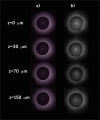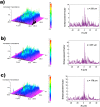UV-shielding and wavelength conversion by centric diatom nanopatterned frustules
- PMID: 30390006
- PMCID: PMC6214969
- DOI: 10.1038/s41598-018-34651-w
UV-shielding and wavelength conversion by centric diatom nanopatterned frustules
Abstract
Diatoms can represent the major component of phytoplankton and contribute massively to global primary production in the oceans. Over tens of millions of years they developed an intricate porous silica shell, the frustule, which ensures mechanical protection, sorting of nutrients from harmful agents, and optimization of light harvesting. Several groups of microalgae evolved different strategies of protection towards ultraviolet radiation (UVR), which is harmful for all living organisms mainly through the formation of dimeric photoproducts between adjacent pyrimidines in DNA. Even in presence of low concentrations of UV-absorbing compounds, several diatoms exhibit significant UVR tolerance. We here investigated the mechanisms involved in UVR screening by diatom silica investments focusing on single frustules of a planktonic centric diatom, Coscinodiscus wailesii, analyzing absorption by the silica matrix, diffraction by frustule ultrastructure and also UV conversion into photosynthetically active radiation exerted by nanostructured silica photoluminescence. We identified the defects and organic residuals incorporated in frustule silica matrix which mainly contribute to absorption; simulated and measured the spatial distribution of UVR transmitted by a single valve, finding that it is confined far away from the diatom valve itself; furthermore, we showed how UV-to-blue radiation conversion (which is particularly significant for photosynthetic productivity) is more efficient than other emission transitions in the visible spectral range.
Conflict of interest statement
The authors declare no competing interests.
Figures









Similar articles
-
Architecture and material properties of diatom shells provide effective mechanical protection.Nature. 2003 Feb 20;421(6925):841-3. doi: 10.1038/nature01416. Nature. 2003. PMID: 12594512
-
The UV filtering potential of drop-casted layers of frustules of three diatom species.Sci Rep. 2018 Jan 17;8(1):959. doi: 10.1038/s41598-018-19596-4. Sci Rep. 2018. PMID: 29343724 Free PMC article.
-
Structure-based optical filtering by the silica microshell of the centric marine diatom Coscinodiscus wailesii.Opt Express. 2014 Jun 30;22(13):15992-9. doi: 10.1364/OE.22.015992. Opt Express. 2014. PMID: 24977855
-
Diatom Frustule Morphogenesis and Function: a Multidisciplinary Survey.Mar Genomics. 2017 Oct;35:1-18. doi: 10.1016/j.margen.2017.07.001. Epub 2017 Jul 19. Mar Genomics. 2017. PMID: 28734733 Review.
-
Diatom Silica for Biomedical Applications: Recent Progress and Advances.Adv Healthc Mater. 2018 Oct;7(19):e1800552. doi: 10.1002/adhm.201800552. Epub 2018 Aug 17. Adv Healthc Mater. 2018. PMID: 30118185 Review.
Cited by
-
Back Accumulation of Diffusive Gradients in Thin-Films Devices with a Stack of Resin Discs To Assess Availability of Metal Cations to Biota in Natural Waters.Environ Sci Technol. 2023 May 23;57(20):7840-7848. doi: 10.1021/acs.est.3c00799. Epub 2023 May 15. Environ Sci Technol. 2023. PMID: 37183959 Free PMC article.
-
The Art of Exploring Diatom Biosilica Biomaterials: From Biofabrication Perspective.Adv Sci (Weinh). 2024 Feb;11(6):e2304695. doi: 10.1002/advs.202304695. Epub 2023 Dec 3. Adv Sci (Weinh). 2024. PMID: 38044309 Free PMC article. Review.
-
Organismal Design and Biomimetics: A Problem of Scale.Biomimetics (Basel). 2021 Sep 28;6(4):56. doi: 10.3390/biomimetics6040056. Biomimetics (Basel). 2021. PMID: 34698083 Free PMC article. Review.
-
Numerical Analysis of the Light Modulation by the Frustule of Gomphonema parvulum: The Role of Integrated Optical Components.Nanomaterials (Basel). 2022 Dec 26;13(1):113. doi: 10.3390/nano13010113. Nanomaterials (Basel). 2022. PMID: 36616023 Free PMC article.
-
Marine-Derived Polymeric Materials and Biomimetics: An Overview.Polymers (Basel). 2020 Apr 26;12(5):1002. doi: 10.3390/polym12051002. Polymers (Basel). 2020. PMID: 32357448 Free PMC article. Review.
References
-
- Kiefer, J. Biological radiation effects (Springer Science & Business Media, 2012).
-
- Karentz D, Cleaver JE, Mitchell DL. Cell survival characteristics and molecular responses of antarctic phytoplankton to ultraviolet-b radiation 1. Journal of Phycology. 1991;27:326–341. doi: 10.1111/j.0022-3646.1991.00326.x. - DOI
-
- Jeffrey SW, MacTavish HS, Dunlap WC, Vesk M, Groenewoud K. Occurrence of UVA- and UVB-absorbing compounds in 152 species (206 strains) of marine microalgae. Marine Ecology Progress Series. 1999;189:35–51. doi: 10.3354/meps189035. - DOI
MeSH terms
Substances
LinkOut - more resources
Full Text Sources
Other Literature Sources

